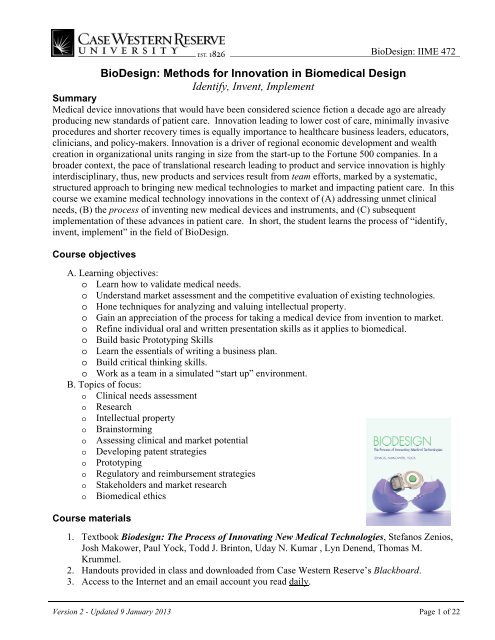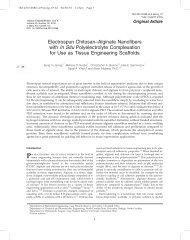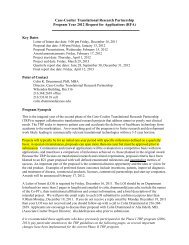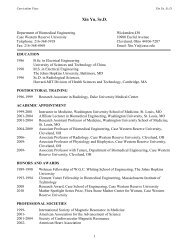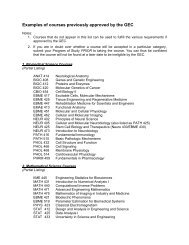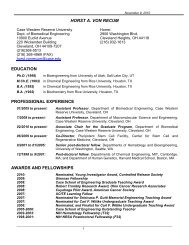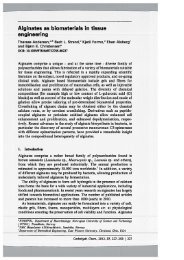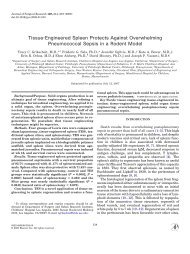here - Department of Biomedical Engineering - Case Western ...
here - Department of Biomedical Engineering - Case Western ...
here - Department of Biomedical Engineering - Case Western ...
You also want an ePaper? Increase the reach of your titles
YUMPU automatically turns print PDFs into web optimized ePapers that Google loves.
BioDesign: IIME 472<br />
BioDesign: Methods for Innovation in <strong>Biomedical</strong> Design<br />
Identify, Invent, Implement<br />
Summary<br />
Medical device innovations that would have been considered science fiction a decade ago are already<br />
producing new standards <strong>of</strong> patient care. Innovation leading to lower cost <strong>of</strong> care, minimally invasive<br />
procedures and shorter recovery times is equally importance to healthcare business leaders, educators,<br />
clinicians, and policy-makers. Innovation is a driver <strong>of</strong> regional economic development and wealth<br />
creation in organizational units ranging in size from the start-up to the Fortune 500 companies. In a<br />
broader context, the pace <strong>of</strong> translational research leading to product and service innovation is highly<br />
interdisciplinary, thus, new products and services result from team efforts, marked by a systematic,<br />
structured approach to bringing new medical technologies to market and impacting patient care. In this<br />
course we examine medical technology innovations in the context <strong>of</strong> (A) addressing unmet clinical<br />
needs, (B) the process <strong>of</strong> inventing new medical devices and instruments, and (C) subsequent<br />
implementation <strong>of</strong> these advances in patient care. In short, the student learns the process <strong>of</strong> “identify,<br />
invent, implement” in the field <strong>of</strong> BioDesign.<br />
Course objectives<br />
A. Learning objectives:<br />
o Learn how to validate medical needs.<br />
o Understand market assessment and the competitive evaluation <strong>of</strong> existing technologies.<br />
o Hone techniques for analyzing and valuing intellectual property.<br />
o Gain an appreciation <strong>of</strong> the process for taking a medical device from invention to market.<br />
o Refine individual oral and written presentation skills as it applies to biomedical.<br />
o Build basic Prototyping Skills<br />
o Learn the essentials <strong>of</strong> writing a business plan.<br />
o Build critical thinking skills.<br />
o Work as a team in a simulated “start up” environment.<br />
B. Topics <strong>of</strong> focus:<br />
o Clinical needs assessment<br />
o Research<br />
o Intellectual property<br />
o Brainstorming<br />
o Assessing clinical and market potential<br />
o Developing patent strategies<br />
o Prototyping<br />
o Regulatory and reimbursement strategies<br />
o Stakeholders and market research<br />
o <strong>Biomedical</strong> ethics<br />
Course materials<br />
1. Textbook Biodesign: The Process <strong>of</strong> Innovating New Medical Technologies, Stefanos Zenios,<br />
Josh Makower, Paul Yock, Todd J. Brinton, Uday N. Kumar , Lyn Denend, Thomas M.<br />
Krummel.<br />
2. Handouts provided in class and downloaded from <strong>Case</strong> <strong>Western</strong> Reserve’s Blackboard.<br />
3. Access to the Internet and an email account you read daily.<br />
Version 2 - Updated 9 January 2013 Page 1 <strong>of</strong> 22
BioDesign: IIME 472<br />
Class location and time<br />
Instructors<br />
Nord Hall, Room 400 Class Number 4501<br />
6:00 pm - 9:00 pm, Tuesdays<br />
As a highly interdisciplinary and applied course <strong>of</strong> study, BioDesign is team-taught by the instructors<br />
listed below, representing experience in medicine, engineering, and business. To draw upon some <strong>of</strong><br />
the most current thinking and practice, many classes throughout the semester feature special guest<br />
speakers.<br />
Shubhayu Basu, PhD<br />
Director, Product Development<br />
Global Cardiovascular Innovation Center<br />
10000 Cedar avenue,<br />
Cleveland, OH 44106<br />
Colin K. Drummond, PhD, MBA<br />
Director, Translational Research Partnership<br />
<strong>Department</strong> <strong>of</strong> <strong>Biomedical</strong> <strong>Engineering</strong><br />
Wickenden Building, Room 316<br />
<strong>Case</strong> <strong>Western</strong> Reserve University<br />
216.445.5930<br />
basus2@ccf.org<br />
216.368.2639<br />
cxd@case.edu<br />
TBD, MD<br />
Medical Research Fellow<br />
<strong>Department</strong> <strong>of</strong> <strong>Biomedical</strong> <strong>Engineering</strong><br />
<strong>Case</strong> <strong>Western</strong> Reserve University<br />
Gary Wnek, PhD<br />
Joseph F. Toot, Jr., Pr<strong>of</strong>essor <strong>of</strong> <strong>Engineering</strong><br />
Faculty Director,<br />
The Institute for Management and <strong>Engineering</strong><br />
Kent Hale Smith building, Room 416<br />
<strong>Case</strong> <strong>Western</strong> Reserve University<br />
216.368.3116<br />
gary.wnek@case.edu<br />
In prior semesters, invited guest speakers have been from organizations such as:<br />
University <strong>of</strong> Minnesota<br />
University <strong>of</strong> Michigan<br />
University <strong>of</strong> Cincinnati<br />
University Hospitals/<strong>Case</strong> Medical School<br />
The Cleveland Clinic<br />
Version 2 - Updated 9 January 2013 Page 2 <strong>of</strong> 22
BioDesign: IIME 472<br />
Overview and approach<br />
The field <strong>of</strong> biomedical engineering has experienced phenomenal growth since its inception as formal<br />
discipline with Universities a mere 4 decades ago. Indeed, in recognition <strong>of</strong> the value that the practical<br />
application <strong>of</strong> biomedical knowledge can yield, many regions <strong>of</strong> the country now strive to excel to<br />
become “centers <strong>of</strong> biomedical innovation” for regional economic development benefit, among other<br />
reasons. At the root <strong>of</strong> successful biomedical innovation are three facets <strong>of</strong> an ecosystem that are used<br />
to frame the current course <strong>of</strong> study:<br />
• Many - if not a majority <strong>of</strong> – ideas leading to medical device innovation are derived from issues<br />
that arise during the daily activities <strong>of</strong> a clinician. Whether it is frustration with the use <strong>of</strong> a<br />
specific surgical instrument, processes that interfere with health care delivery, or materials<br />
inadequate for intended outcomes, an ecosystem w<strong>here</strong> practicing medical pr<strong>of</strong>essionals can<br />
engage with engineers is a primary precondition for fostering innovation.<br />
• Medicine is a highly interdisciplinary field centered on patient care. Some <strong>of</strong> the most<br />
successful innovations are those with patient care objectives at the forefront <strong>of</strong> thinking (not<br />
research career objectives) based on an interdisciplinary mindset. Pretending does not do the<br />
trick; t<strong>here</strong> is no substitute for cutting across organizational boundaries and genuinely<br />
embracing teamwork in the problem solution process.<br />
• Despite many myths about innovation and creativity, quite a few processes related to medical<br />
device innovation are marked by systematic, structured approaches that can be learned. These<br />
are amenable to a University setting as each student can, in fact, acquire and improve the<br />
requisite knowledge and critical thinking skills on the subject.<br />
The structure <strong>of</strong> this course provides each participant a hands-on, first-hand experience with the three<br />
principles <strong>of</strong> innovation described above; more concisely captured in the phrase: “identify, invent, and<br />
implement.” We have structured the course as a diverse mix <strong>of</strong> methods and activities that take place<br />
individually and in groups. The tentative outline <strong>of</strong> classes (see page 6) illustrates that lectures are<br />
really only one facet <strong>of</strong> this course. Since we will strive for (and measure) meaningful student input,<br />
so it is recommended you read the assigned chapters (or cases, or articles) before you come to class<br />
and spend some time thinking about the material and reflecting on issues with your colleagues. Come<br />
as prepared for class as you would if you were going to meet a patient.<br />
In very short order it will be clear this class is not about the abstract presentation <strong>of</strong> theories,<br />
abandoned once the final exam has been completed. Rather, the course begins with an introduction on<br />
“unmet clinical needs.” The first assignment is centered on your individual efforts to shape and<br />
articulate a medical need through a formalized “needs analysis.” This initial phase <strong>of</strong> the course is<br />
followed almost entirely by team activity. Students are subsequently grouped into project teams (3-4<br />
members/team) to drive forward projects culminating in a “pitch” to venture capitalists and a business<br />
plan submission. Throughout the semester it will become increasingly clear that the calendar and<br />
agenda (page 6) map very closely the principles outlined above.<br />
We encourage you to develop your own concept map and adapt what we teach to your individual<br />
learning style; discuss this and debate with others. Biodesign is a “contact sport” and your ability and<br />
willingness to make meaningful contributions are an essential facet <strong>of</strong> course value. Share your<br />
concerns and ideas with the entire class, not just the person sitting next to you. This is your chance to<br />
focus on learning a very unique process. Many concepts in BioDesign are learned iteratively, so feel<br />
free to ask questions; besides, it will enhance your class participation grade.<br />
Version 2 - Updated 9 January 2013 Page 3 <strong>of</strong> 22
BioDesign: IIME 472<br />
Grading: Portfolio <strong>of</strong> tasks and weights<br />
T<strong>here</strong> is no “curve” for the grade earned under the assumption that each class participant is motivated to seek their<br />
“personal best” against a series <strong>of</strong> tasks and milestones, not competing against each other. Grades are a traditional 90-A /<br />
80-B / 70-C or “Pass”/”Fail” depending on the way you registered for the course (i.e., School <strong>of</strong> Medicine is <strong>of</strong>ten P/F).<br />
Unlike other courses, you are not measured by what you get as the end result <strong>of</strong> the project you work on in this course, but<br />
rather by what you get out <strong>of</strong> the course itself. The more effort you give to this course, the more real life learning you will<br />
get out <strong>of</strong> it. Essentially, the more you give to this course in terms <strong>of</strong> effort, participation, thought, intellect and sweat – the<br />
more you will get out <strong>of</strong> it – much beyond just a grade.<br />
1. Class Participation and Attendance 10%<br />
i. Attendance is essential in a course like this since this is a wonderful time to learn interactively,<br />
discuss issues with colleagues, check your knowledge <strong>of</strong> the material, and efficiently focus attention<br />
on specific class subject discussions.<br />
ii Only one (1) unexcused absence will be permitted. Additional absences will permanently limit the<br />
maximum grade possible for the course.<br />
2. Needs Analysis Assignment (Assignment 1) 15%<br />
i. All assignments, including the needs analysis, are listed on the course agenda (beginning on page 6)<br />
and must be completed on time. Follow the lecture plans carefully as t<strong>here</strong> are several components<br />
to the Needs Analysis!<br />
ii. It is highly recommended that you carefully plan your schedule in the weeks ahead to ensure the<br />
presentation is completed on time. The first deadline will arrive quickly!<br />
3. Concept Evaluation Assignments (Assignments 2 , 3, & 4) 30%<br />
i. These assignments are designed to keep the team on track with the project and to think through<br />
each stage <strong>of</strong> BioDesign in a structured format.<br />
Assignment 2 will require the teams to present concept maps <strong>of</strong> their brainstorming sessions and a<br />
detailed market analysis <strong>of</strong> their solution/ need. (10%)<br />
Assignment 3 addresses the lead concept and a rationale <strong>of</strong> the analysis that lead to the team<br />
selection. A lead IP claim is also expected. (10%)<br />
Assignment 4 should present a rudimentary first prototype & expected development pathway. (10%)<br />
4. Peer assessment 10%<br />
i. Throughout the semester t<strong>here</strong> are a variety <strong>of</strong> team assignments and activities. Your contribution<br />
to the team, commitment to constructive interactions, preparation for group exercises (reflecting<br />
knowledge, skills and abilities), emphasis on quality work, and contributions to deliverables will be<br />
subject to peer evaluation.<br />
ii. We will use the CATME system to establish the peer evaluation score. This system is an on-line<br />
system that requires you to answer a series <strong>of</strong> questions. We will have a mid-term peer evaluation<br />
to ensure everyone is able to use the CATME system, and to provide feedback so you can take<br />
corrective action on team performance prior to the final peer evaluation on Wednesday 27 April, to<br />
be used in the final grade computation.<br />
5. Business Plan Summary 35%<br />
i. The written Business Plan Summary is a key deliverable by each team. A significant demonstration<br />
<strong>of</strong> your competency in BioDesign is the ability to write a pr<strong>of</strong>essional business plan summary; this<br />
will be a group exercise that will follow a prescribed format and timeline, with the deliverable a<br />
written report (15%).<br />
ii. As a “hands-on” course enabling class participants the opportunity to engage in facilitated realworld<br />
BioDesign experiences, external industry stakeholders are used to assist in assessment <strong>of</strong><br />
competencies in biomedical product innovation. On the last day <strong>of</strong> class – in place <strong>of</strong> a written<br />
final exam -- student teams will present their business plan to a panel <strong>of</strong> venture investors. The<br />
panel’s assessment <strong>of</strong> each project in included in the course grade calculation (20%).<br />
Version 2 - Updated 9 January 2013 Page 4 <strong>of</strong> 22
BioDesign: IIME 472<br />
Special notes on laptops, cell-phones, and other mobile electronics<br />
Unless otherwise announced, t<strong>here</strong> is a “no-cell-phone” policy during class lectures:<br />
a. Devices such as an iPhone or Blackberry should also be turned <strong>of</strong>f.<br />
b. Notes and slides will be available through Blackboard in advance or distributed in class.<br />
c. If t<strong>here</strong> is some special circumstance dictating that you need to be contacted by your cell<br />
phone or iPhone during a specific class, please notify the instructor in advance.<br />
i. We acknowledge that as a graduate level course some clinical participants have<br />
unavoidable pr<strong>of</strong>essional responsibilities (resident on-call, etc.). In these cases<br />
we simply ask that, say, a pager be set on “vibrate” mode and that it is only a<br />
matter <strong>of</strong> quietly leaving the classroom if a call comes in.<br />
ii. The objective is not to impede a participant’s need to respond to pr<strong>of</strong>essional calls,<br />
only that such contact is minimally disruptive to the class.<br />
d. T<strong>here</strong> will be specific sections in the class which will require you to use a computer or<br />
laptop to access information for research on your project and for moving it forward. In such<br />
cases, be prepared to have your computer ready for use.<br />
e. However, an open laptop will not be tolerated during any other circumstance.<br />
f. The Instructor will not “beg” or “pester” you to “please turn <strong>of</strong>f all devices”; you will<br />
simply receive a zero for attendance for that class.<br />
Ethics<br />
Our student academic integrity policy has many <strong>of</strong> the elements you would expect from any highquality<br />
educational institution. <strong>Case</strong> <strong>Western</strong> Reserve University has a well defined policy on<br />
violations <strong>of</strong> academic integrity (see: www.case.edu/gradstudies/downloads/AcadInteg.pdf and the<br />
website http://www.case.edu/gradstudies/current/policies.html). For your convenience, the following<br />
abstract represents select items cut-and-paste from various parts <strong>of</strong> University policy:<br />
“If an instructor suspects a violation in the form <strong>of</strong> cheating, plagiarism, misrepresentation or<br />
obstruction, this is what must happen:<br />
o The instructor must confront the violator(s) with the suspicion, including the evidence and the<br />
report describing the violation.<br />
o At the end <strong>of</strong> this meeting, unless the instructor is convinced that no violation occurred,<br />
whether or not the student agrees that a violation occurred, both sign the report and it is<br />
submitted to the Office <strong>of</strong> Graduate Student Affairs.”<br />
“If the violator(s) agrees that the violation occurred, the student checks the box so indicating, and signs<br />
the report. The instructor decides whether to impose a sanction or pass the case along to the academic<br />
integrity board. The minimum sanction the instructor may impose is failure in the work (NOT reduced<br />
credit). The maximum the instructor may impose is failure in the course. If this range doesn't seem<br />
appropriate, then the case should be referred to the academic integrity board with explanation.”<br />
“If the student doesn't agree that a violation occurred, or if the student doesn't agree that the instructor's<br />
sanction is appropriate, then he/she checks the appropriate box so indicating, signs the report, and the<br />
case goes to the academic integrity board. The report with supporting evidence and explanation goes<br />
to the Office <strong>of</strong> Student Affairs and they schedule a hearing with the student.”<br />
“It merits emphasis that the report should always be submitted, even if the instructor is the one to<br />
impose the sanction and no AI hearing is required. Otherwise a student could commit multiple<br />
violations and be treated by each compassionate instructor as a first-time <strong>of</strong>fender. Policy for<br />
subsequent violations are different, and not in the hands <strong>of</strong> instructors.”<br />
Version 2 - Updated 9 January 2013 Page 5 <strong>of</strong> 22
BioDesign: IIME 472<br />
Overview <strong>of</strong> Agenda and 2013 Calendar<br />
Session Topic and preparatory work Assignment Due<br />
Needs Identification<br />
1. 15-January Needs Finding: Observation and Problem Identification<br />
Textbook Chapter 1; Sections 1.1 and 1.2<br />
2. 22-January Needs Finding: Need Statement Development<br />
Needs Validation<br />
Textbook Chapter 1; Section 1.3<br />
3. 29-January Needs Screening: Validation<br />
BioDesign Video link: Todd Brinton Lecture<br />
Short Biography<br />
Needs Topic<br />
4. 5-February Needs Analysis and Clinical Q&A Assignment 1(15%)<br />
Concept Generation<br />
Student presentations<br />
Assignment 1 has 2 parts: (1) Needs analysis presentation and (2) team formation (see p.10-12)<br />
5. 12-February Concept Generation: Brainstorming and Prototyping Basics<br />
Concept Selection<br />
Chapter 3, Section 3.1 & Chapter 4, Section 4.5<br />
6. 19-February Intellectual Property Strategy Team Charter Due<br />
Chapter 4, Sect.4.1; Needs Analysis Presentation Due!<br />
7. 26-February Concept Selection with focus on Market Analysis<br />
8. 5-March Regulatory Basics<br />
Chapter 3, Section 3.2, pp.193-204<br />
Chapter 5, Section 5.4, pp.458-472 Assignment 2(10%)<br />
Assignment 2 has 2 parts: (1) concept maps and (2) market analysis (see p.15-16)<br />
9. 19-March Development Strategy and IP Claims Workshop<br />
Chapter 5, Section 5.3, pp.425-457.<br />
10. 26-March Fundamentals <strong>of</strong> Reimbursement<br />
Concept Implementation<br />
Chapter 5, Section 5.6, pp.503-535; Assignment 3 Due!! Assignment 3(10%)<br />
Assignment 3 has 3 parts (see pp.16-17):<br />
1. IP search results<br />
2. Lead concept<br />
3. Rationale <strong>of</strong> arrival to lead concept<br />
11. 2-April Financial Models and Operating Plans<br />
Chapter 6, Sections 6.1, pp.612-656<br />
Version 2 - Updated 9 January 2013 Page 6 <strong>of</strong> 22
BioDesign: IIME 472<br />
Concept Implementation (continued)<br />
12. 9-April Funding and Business Planning<br />
Chapter 6, Sections 6.2 & 6.3, pp.657-707. Assignment 4 (10%)<br />
Assignment 4 has 2 parts (see pp.18-19)<br />
1. Regulatory Implications, Clinical strategy and development plan and timeline and<br />
2. Rudimentary prototype<br />
13. 16-April Market and Exit Strategies Draft Pr<strong>of</strong>orma & IDF<br />
14. 23-April Presentation Coaching<br />
Chapter 5, Sect. 5.7-5.8; Pr<strong>of</strong>orma &Invention Disclosure Due!!<br />
Faculty review <strong>of</strong> final presentations<br />
15. 30-April Course Review and Student Presentations to Investors Assignment 5<br />
Key Course Modules<br />
Assignment 5 has 2 parts: (1) Business plan summary and (2) final presentation (see p.21-22)<br />
The art and practice <strong>of</strong><br />
problem identification<br />
Needs statements and<br />
specifications<br />
Identify<br />
Clinical validation<br />
Brainstorming and<br />
concept selection<br />
Prototyping<br />
Regulatory issues,<br />
concerns, and perspective<br />
Reimbursement and<br />
market considerations<br />
Intellectual property<br />
Business models<br />
Invent<br />
Clinical pathways for<br />
market clearance<br />
Financial strategic<br />
development<br />
Marketing and sales<br />
strategies<br />
Implement<br />
Advocacy and business plan<br />
presentations<br />
January 2013<br />
S M T W T F S<br />
1 2 3 4 5<br />
6 7 8 9 10 11 12<br />
13 14 15 16 17 18 19<br />
20 21 22 23 24 25 26<br />
27 28 29 30 31<br />
February<br />
S M T W T F S<br />
1 2<br />
3 4 5 6 7 8 9<br />
10 11 12 13 14 15 16<br />
17 18 19 20 21 22 23<br />
24 25 26 27 28<br />
March<br />
S M T W T F S<br />
1 2<br />
3 4 5 6 7 8 9<br />
10 11 12 13 14 15 16<br />
17 18 19 20 21 22 23<br />
24 25 26 27 28 29 30<br />
31<br />
April<br />
S M T W T F S<br />
1 2 3 4 5 6<br />
7 8 9 10 11 12 13<br />
14 15 16 17 18 19 20<br />
21 22 23 24 25 26 27<br />
28 29 30<br />
Version 2 - Updated 9 January 2013 Page 7 <strong>of</strong> 22
BioDesign: IIME 472<br />
Session 1 - Needs Identification<br />
Executive Summary<br />
For some technologists, the thrill <strong>of</strong> solving complex problems <strong>of</strong>ten transcends the importance or<br />
proper definition <strong>of</strong> the problem. Investors frequently encounter this situation -- t<strong>here</strong> are a myriad <strong>of</strong><br />
medical problems, but not all <strong>of</strong> them significant or <strong>of</strong> such a priority that a statement <strong>of</strong> need can be<br />
crafted. Absent a proper needs statement it is unlikely the subsequent problem solution has a<br />
compelling basis that will command the attention <strong>of</strong> key stakeholders (investors and clinicians alike!)<br />
in the health care ecosystem. The central theme <strong>of</strong> today’s class session is to understand the basic<br />
principles underlying the basic principles and practice <strong>of</strong> problem identification. This centers around<br />
technique (and preparation) for clinical observations, the ability to subsequently differentiate between<br />
problems and needs, and finally the (acquired) skills to articulate a problem amenable to methods for<br />
innovation in medical product design.<br />
Learning Objectives<br />
After reading and discussion sessions, the student should be able to:<br />
• Understand the general framework <strong>of</strong> BioDesign as a structured course <strong>of</strong> study<br />
• Articulate at least 3 important elements <strong>of</strong> BioDesign principles (identify, invent,<br />
implement) and why they matter.<br />
• Recognize the 6 steps <strong>of</strong> the process for performing observations and identifying problems.<br />
• Describe the difference – and reasoning for – needs analysis preceding the needs<br />
specification.<br />
• Differentiate between observations, problems, and needs<br />
• Understand key stakeholder perspectives and the impact on needs analysis.<br />
• Identify the types <strong>of</strong> problems that <strong>of</strong>ten result in development <strong>of</strong> clinical needs<br />
Links to Explore<br />
Stanford BioDesign website<br />
a. http://www.stanford.edu/group/biodesign/cgi-bin/ebiodesign/<br />
b. http://biodesign.stanford.edu/bdn/resources/video.jsp<br />
Assignments<br />
• Due in 3 days: Submit a 1-paragraph biography (include a picture, please), your learning<br />
objectives for this course. Due Date: This must be submitted through Blackboard no later<br />
than 5:00 pm Friday January 18 th so that a class pr<strong>of</strong>ile can be compiled in advance <strong>of</strong><br />
Session 2.<br />
Preparatory Reading<br />
BioDesign Textbook: Chapter 1; Sections 1.1 and 1.2, pp.3-36<br />
Version 2 - Updated 9 January 2013 Page 8 <strong>of</strong> 22
BioDesign: IIME 472<br />
Session 2 - Needs Identification<br />
Executive Summary<br />
This class Session we take the discussion <strong>of</strong> observations and observed clinical problems to the next<br />
logical step: the development <strong>of</strong> a statement <strong>of</strong> need. While several aspects <strong>of</strong> today’s discussion may<br />
overlap previous topics, t<strong>here</strong> is now a greater action orientation. That is, it is one thing to observe and<br />
quite another to translate the observations into a written statement. Although the novice might view<br />
this process as “a lot <strong>of</strong> guesswork” a sign <strong>of</strong> student success in comprehension is the understanding <strong>of</strong><br />
what it is that makes a need statement too narrow, too broad, or self-limiting in form. Anticipating the<br />
in-class exercise to draft a needs statement, t<strong>here</strong> is no question that reading Section 1.3 in advance<br />
will be critical to getting the most out <strong>of</strong> today’s session. In particular, the <strong>Case</strong> Study on<br />
Northwestern (p.43) along with the figure illustrating the “cascade <strong>of</strong> needs” (Figure 1.3.4 on page 46)<br />
should be thoroughly explored prior to the start <strong>of</strong> class. This will prepare you for the presentation you<br />
will need to make for Session 3.<br />
Learning Objectives<br />
After reading, discussion, and interactive class sessions, the student should be able to:<br />
• Understand the clinical basics <strong>of</strong> peripheral artery disease to act as a background for the<br />
needs that are assigned to the teams<br />
• Understand the major pitfalls associated with poorly developed need statement<br />
o Implicitly embedded solutions (“how” versus “what”)<br />
o Impact <strong>of</strong> constraints (needs that are too broad or too narrow).<br />
• Describe the underlying process for translating an observed problem into a clinical need<br />
o Steps to shaping a needs statement<br />
o Outcomes and their role in the needs statement<br />
• Outline the different types <strong>of</strong> needs and the relation to product “risk vs benefit”<br />
o Incremental need zone<br />
o Mixed need zone<br />
o “Blue-sky” need zone<br />
Link to Explore<br />
Johns Hopkins University BioDesign website (focus on global health)<br />
a. http://cbid.bme.jhu.edu/educational-programs/global-health.php<br />
Assignments<br />
• Prior to the end <strong>of</strong> class: Select and submit prior to the end <strong>of</strong> today’s class session your<br />
“top-three” Needs Statements from the list distributed in class. Your preferences will be<br />
reviewed and subsequently a Need assigned to you by 5:00 pm Thursday January 24th.<br />
Every effort will be made to match you with at least one <strong>of</strong> the Needs Statements <strong>of</strong> your<br />
choice (but no guarantees).<br />
• Due before next class: Prepare a 1-slide presentation <strong>of</strong> your assigned need (from Session<br />
1). You will provide a refined needs statement and two (2) clinician questions. Due date:<br />
This must be submitted through Blackboard no later than 10:00 pm Monday January 28 th<br />
so that these can be reviewed in advance <strong>of</strong> class on Tuesday January 29th.<br />
Preparatory Reading<br />
Biodesign Textbook: Chapter 1, Section 1.3, pp.37-55<br />
Version 2 - Updated 9 January 2013 Page 9 <strong>of</strong> 22
BioDesign: IIME 472<br />
Session 3 - Needs screening: Validation<br />
Executive Summary<br />
Once a need is identified and Needs Statement has drafted, it is essential to go through the Validation<br />
process. This step can be viewed as an “insurance policy” for the relevance for the need you will<br />
subsequently proceed to find a solution. In the zeal to work on and solve problems, the innovator may<br />
want to rush through the validation step, but this phase <strong>of</strong> “evidence based” inquiry is quite critical.<br />
Every word in the needs statement must be examined. Is every word necessary? Do certain words<br />
unnecessarily restrict or broaden the problem? Is language used that imbeds a solution?<br />
Accompanying this process is the need to gain multiple perspectives on the need; have you spoken<br />
with a variety <strong>of</strong> people who might face the same need but whose perspectives differ? How does a<br />
nurse see the need? And how does that compare with a patient’s view? The subject <strong>of</strong> “Validation” is<br />
best experienced first-hand (versus lectured about) so Session 3 features facilitated student activity to<br />
exercise and underscore key learning objectives.<br />
Learning Objectives<br />
After reading, discussion, and interactive class activity, the student should be able to:<br />
• Identify pitfalls with poorly developed need statement<br />
o Assess if statements are too broad or too narrow<br />
o Asses if solutions are imbedded (“how” versus “what”)<br />
• Demonstrate competency in translating and observed problem into a clinical need<br />
o Know the basic steps to shaping a needs statement<br />
• Be able to prepare questions to assist in the validation process<br />
o Formulate multiple perspectives on the needs statement<br />
o Know the key stakeholders to communicate with<br />
Link to Explore<br />
Todd Brinton video on needs finding and validation<br />
• http://biodesign.stanford.edu/bdn/video/20080114_ToddBrinton_bioe374.jsp<br />
Assignments<br />
• Due for class today: Present a refinement <strong>of</strong> the 1-slide needs statement with two questions<br />
for the clinicians<br />
• Due next class: Feedback from today’s Session should help you refine your development<br />
<strong>of</strong> the Needs analysis presentation, due through Blackboard no later than 5:00 pm Tuesday<br />
February 5th st . Please see the Grading portfolio and weighting (page 4 <strong>of</strong> this syllabus) for<br />
more information. You will be presenting it in class as well.<br />
Preparatory Video<br />
BioDesign Link: Video (link above) is almost 2 hours in length!<br />
Version 2 - Updated 9 January 2013 Page 10 <strong>of</strong> 22
BioDesign: IIME 472<br />
Session 4 - Needs analysis: Summary presentations<br />
Assignment 1<br />
• Due today via Blackboard before 5.00pm EST: A powerpoint presentation <strong>of</strong> your<br />
“Needs Analysis”. This is worth 15% <strong>of</strong> your grading. Your ability to answer questions<br />
regarding your depth <strong>of</strong> knowledge about the need is critical in the grading process.<br />
• In class today: During the class networking session, the goal is for tentative teams to be<br />
formed around common interest in a Needs statement. Within 2 days, a “communications<br />
coordinator” for each team should be identified, and that person will provide through<br />
Blackboard a summary <strong>of</strong> the team membership and the Need being addressed.<br />
Version 2 - Updated 9 January 2013 Page 11 <strong>of</strong> 22
BioDesign: IIME 472<br />
Session 5 - Concept generation: Brainstorming<br />
Executive Summary<br />
Often people will state that “I’m really not good at idea generation since I don’t have much creative<br />
genius” which perpetuates several unfortunate myths about the creative process. Today is not about<br />
the “ah ha” moment; and actually, idea creation (or “ideation”) will be shown to involve a number <strong>of</strong><br />
skills the typical person can acquire. Very little actually happens “by accident” and in this Session we<br />
focus primarily on the brainstorming technique. Yes, many people have heard <strong>of</strong> this, but the context<br />
<strong>of</strong> medical technology puts a slightly different spin on the process. In particular,<br />
a. A multidisciplinary team effort is required<br />
b. Idea generation must be distinct from implementation probability<br />
c. A systems approach is essential (regulatory, reimbursement, medical protocol, etc.)<br />
d. The Needs Specification is crucial.<br />
Indeed, the ideation process is iterative – particularly if some team members are new to the process –<br />
and any deficiencies in the Needs Statement (too broad, too narrow) will be obvious quite quickly.<br />
Ideation is a critical path and the gateway to product concept generation. If past BioDesign class<br />
experiences remain true, today’s hands-on session will not only be exceptionally productive session,<br />
but a great time for Team members to get to know each other better.<br />
Learning Objectives<br />
After reading and today’s brainstorming class activity, the student should be able to<br />
(taken directly from Biodesign, pages 176):<br />
• Understand the role <strong>of</strong> ideation in the context <strong>of</strong> the biodesign innovation process<br />
• Learn the basic methods <strong>of</strong> brainstorming and how to plan and execute a session<br />
• Consider special approaches to brainstorming specific to biotechnology invention<br />
Link to Explore<br />
Wikipedia is useful in this case (still, peer review absent)<br />
• http://en.wikipedia.org/wiki/Brainstorming<br />
This, not exactly from Harvard, but interesting ideas:<br />
• http://harvardplanner.com/proactive/default.asp<br />
Assignments<br />
• Due next class: Complete and sign the “Team Charter” and submit at the start <strong>of</strong> the next<br />
class, Session 6, Tuesday 19th February, 2013.<br />
Preparatory Reading<br />
Biodesign Textbook: Chapter 3, Section 3.1, pp.176-192<br />
Review and understand highlights <strong>of</strong> Sesion 3.1 (p.193)<br />
Prototyping Chapter 4, Section 4.5, pp.340-366<br />
Version 2 - Updated 9 January 2013 Page 12 <strong>of</strong> 22
Session 6 - Concept selection: Intellectual property considerations<br />
BioDesign: IIME 472<br />
Executive Summary<br />
Intellectual property (IP) is <strong>of</strong> fundamental importance if the innovation team wishes to secure capital<br />
and returns on the work to conceptualize and create a product. Of course, IP is not required –<br />
particularly if the effort being undertaken is for the so-called “greater good” – but for the majority <strong>of</strong><br />
medical products you really can’t attract interest or attention to your ideas is t<strong>here</strong> is not even the hope<br />
<strong>of</strong> IP protection. Central to securing one form <strong>of</strong> IP, a patent, are the claims <strong>of</strong> a patent – these are <strong>of</strong><br />
central interest as they are the basis for your (temporary) monopoly over the product market. Today’s<br />
session t<strong>here</strong>fore is highly focused on (A) IP strategy and (B) development <strong>of</strong> specific student skill in<br />
understanding how to create and critique Patent claims. In the past the interactive exercise has been <strong>of</strong><br />
most benefit to students who have completed the assigned reading and we have populated this Outline<br />
with several reminders to ensure and encourage your advance preparatory effort.<br />
Learning Objectives<br />
After reading and today’s ;ectures, the student should be able to<br />
(taken directly from Biodesign, page 210):<br />
• Understand the different types <strong>of</strong> patents, including the basic elements <strong>of</strong> provision and<br />
utility patents<br />
• Recognize the requirements <strong>of</strong> patentability, including practical aspects <strong>of</strong> the filing process<br />
for medical devices.<br />
• Develop familiarity with the patent search process<br />
• Understand the fundamentals <strong>of</strong> international patent coverage<br />
Link to Explore … we mean, really, explore these before class<br />
You just have to jump on this extraordinarily important website<br />
• http://www.uspto.gov<br />
World intellectual property organization<br />
• http://www.wipo.int/portal/index.html.en<br />
Justia – Advancing the availability <strong>of</strong> legal resources for the benefit <strong>of</strong> society.<br />
• http://www.justia.com/<br />
Preparatory Reading<br />
Biodesign Textbook: Chapter 4, Section 4.1, pp.210-271<br />
A very long section, but is essential to read in advance so that the lecture<br />
sessions do not have to resort to being redundant tutorials – it is essential<br />
we be prepared to discuss the strategic aspects <strong>of</strong> claims development.<br />
Assignments<br />
• Due today: Completed and signed “Team Charter” in paper.<br />
Version 2 - Updated 9 January 2013 Page 13 <strong>of</strong> 22
BioDesign: IIME 472<br />
Executive Summary<br />
Session 7 - Concept generation: Concept screening<br />
At this point in the semester (we are 40% through the course already!) it should be evident the Needs<br />
Specification – the subject <strong>of</strong> the first 16% <strong>of</strong> class discussion – plays a central and unique role in<br />
BioDesign. The process <strong>of</strong> ideation to generate ideas is as disciplined a process as the (again,<br />
acquired) skill <strong>of</strong> screening and selection <strong>of</strong> concepts. Indeed the time invested by the innovator to<br />
methodically “downselect” ideas is not a wasted effort (no, it is not usually “obvious” the “right”<br />
answer), and, in fact results in the improved efficiency in due diligence <strong>of</strong> the few concepts.. However,<br />
the unique aspect <strong>of</strong> BioDesign is that the Needs Specification is the backdrop and centerpiece <strong>of</strong> an<br />
efficient concept screening activity. The transition from ideation to screening involves three major<br />
steps:<br />
• Principles <strong>of</strong> grouping and organizing ideas<br />
• Formalized methods for organizing or “clustering” ideas (sometimes with s<strong>of</strong>tware), and<br />
• Mapping the clusters relative to the need.<br />
All <strong>of</strong> this, then leads to a visual method for understanding if solution “clusters” are mapped to the<br />
need, or when visial gaps arise t<strong>here</strong> become areas w<strong>here</strong> further brainstorming may be needed.<br />
Todays session will hopefully include a hands-on concept mapping session, but this may require<br />
additional work with faculty engaged outside the time allotted for today (Session 6).<br />
Learning Objectives<br />
After reading (well, we hope you read), discussion, and today’s demonstrations, the student should<br />
be able to:<br />
• Understand this phase <strong>of</strong> the ideation process in the context as a structured methodology for<br />
filtering ideas that have emerged from the brainstorming session.<br />
• Understand and have the ability to organize the output from a brainstorming session.<br />
• Know the strategies (Table 3.2.1) and resources available to assist in concept mapping<br />
• Specific emphasis on tools for concept mapping<br />
• Summarize the relationships between concept mapping, concept screening, and concept<br />
selection.<br />
• Recite at least three <strong>of</strong> the main benefits to rapid prototyping<br />
Link to Explore<br />
IHMC CMAP Tools<br />
• http://cmap.ihmc.us/conceptmap.html<br />
A survey <strong>of</strong> concept mapping<br />
• http://datalab.cs.pdx.edu/sidewalk/pub/survey.<strong>of</strong>.concept.maps/<br />
Assignments<br />
• Assignment 2 due next Tuesday by 5pm, to be submitted via Blackboard<br />
Preparatory Reading for Today<br />
Biodesign Textbook: Concept Screening:<br />
Chapter 3, Section 3.2, pp.193-204<br />
Version 2 - Updated 9 January 2013 Page 14 <strong>of</strong> 22
BioDesign: IIME 472<br />
Session 8 - Concept selection: Regulatory basics<br />
Executive Summary<br />
Those new to medical device design might be inclined to seek or emphasize product material<br />
selections that are “cost-effective.” While consideration <strong>of</strong> cost might make for a competitive product<br />
from the perspective <strong>of</strong> the manufacturer, this overlooks the role and value <strong>of</strong> regulatory agencies in<br />
the medical product development and launch process. It is <strong>of</strong>ten underappreciated the creation and<br />
subsequent growth in the regulatory power <strong>of</strong> the FDA throughout its brief history has frequently been<br />
a direct result <strong>of</strong> individuals harmed by mislabeled, untested, adulterated, or toxic products that were<br />
well-marketed, not well-tested – in this regard the FDA can be credited for “…help[ing] pull medicine<br />
into the modern era”(Hamburg 2010). Anticipating that most medical devices need to be cleared or<br />
approved by the FDA prior to being marketed for sale in the US, the advantages <strong>of</strong> low-cost materials<br />
are irrelevant if the device cannot be presented to the marketplace due to failed regulatory compliance.<br />
Today’s Session explores the context <strong>of</strong> FDA regulation from several perspectives since it was the<br />
unanticipated consequences <strong>of</strong> new technology – and the way the technology was brought to market --<br />
that spurred the medical device regulatory framework as we have it today. Though the lectures and<br />
Session discussions it will emerge that regulatory concerns should not be marginalized as something<br />
the innovator “has to do,” but rather an important stakeholder throughout the innovation process.<br />
Learning Objectives<br />
After reading and today’s workshop activity, the student should be able to<br />
(taken directly from Biodesign, page 458):<br />
• Understand the strategic risks and opportunities associated with the PMA and 510(K)<br />
pathways.<br />
• Appreciate how and when to communicate with the FDA<br />
• Consider how a global regulatory strategy can be integrated with the approach to the FDA.<br />
• Recognize common regulatory mistakes and learn how to avoid them through the creation<br />
and implementation <strong>of</strong> a strong regulatory strategy.<br />
• The steps in product development<br />
• Design Freeze, design reviews, Verification and Validation, bench and preclinical testing<br />
requirements<br />
A Very Important Link to Explore<br />
US Food and Drug Administration Home Page<br />
• http://www.fda.gov<br />
InterCenter Tissue <strong>Engineering</strong> Working Group and the Tissue <strong>Engineering</strong> Initiative<br />
• http://www.fda.gov/MedicalDevices/<br />
DeviceRegulationandGuidance/Standards/ucm135382.htm<br />
Assignments<br />
• Assignment 2 due<br />
o Concept Maps and Market analysis on your brainstormed concepts<br />
Preparatory Reading<br />
Biodesign Textbook: Chapter 5, Section 5.4, pp.458-472<br />
Version 2 - Updated 9 January 2013 Page 15 <strong>of</strong> 22
BioDesign: IIME 472<br />
Session 9 - Concept selection: Development Strategy and Claims Workshop<br />
Executive Summary<br />
The FDA Approval process is under a lot <strong>of</strong> scrutiny by the agency itself and each product recall<br />
brings with it the question about additional data before any product is approved. The development<br />
process for any medial device includes careful bench validation, pro<strong>of</strong> <strong>of</strong> concept both in preclinical as<br />
well as human subjects. Clinical trails are studies conducted using human participants by researchers in<br />
government labs, medical schools, or by pharmaceutical or medical manufacturers, to test how well a<br />
new drug, medical device, diagnostic tool, therapy, treatment or form <strong>of</strong> prevention works to improve<br />
health, cure disease, or improve quality <strong>of</strong> life. The goal is to test efficacy and safety. Students need to<br />
appreciate the complexities in planning, designing and executing a project from initial pro<strong>of</strong> <strong>of</strong> concept<br />
to clinical trial and the implications <strong>of</strong> success or failure at each step.<br />
Building <strong>of</strong>f previous lectures on intellectual property this lecture aims to involve the students in a<br />
process <strong>of</strong> developing lead claims on their lead concept. Guided by <strong>Case</strong> Tech Transfer personnel, this<br />
session is always engaging, immensely beneficial in its content and activity and fun at the same time.<br />
Learning Objectives<br />
After reading and today’s workshop activity, the student should be able to:<br />
• Understand different types <strong>of</strong> clinical trials<br />
• Understand the implications <strong>of</strong> clinical strategies in medical device development<br />
• Be able to assess the most likely clinical strategy for their project<br />
…. and as a direct result <strong>of</strong> class activities…<br />
• Synthesize information from the readings and lectures to enable patent claims to be<br />
written.<br />
• Critique patent claims for critical (and common) deficiencies<br />
• Articulate a variety <strong>of</strong> stakeholder perspectives related to patent litigation strategies<br />
Assignments<br />
No written or oral reports due today or assigned for next Session<br />
• BUT, plan and prepare for<br />
o Assignment 3 which is due on Tuesday 26 th March<br />
Preparatory Reading<br />
Biodesign Textbook: Chapter 5, Section 5.3, pp.425-457<br />
Version 2 - Updated 9 January 2013 Page 16 <strong>of</strong> 22
BioDesign: IIME 472<br />
Executive Summary<br />
Session 10 - Concept selection: Reimbursement<br />
Creating a reimbursement strategy is challenging and complex. If no-one pays for your innovation, no<br />
one will fund it to begin with! Most companies and entrepreneurs will benefit from hiring the services<br />
<strong>of</strong> a reimbursement consultant. However, this lecture will enable entrepreneurs to assess and<br />
understand the field <strong>of</strong> innovation they are playing in, current coverages, gaps and opportunities.<br />
Learning Objectives<br />
After reading and today’s workshop activity, the student should be able to:<br />
• Recognize that regulatory approval does not guarantee reimbursement<br />
• Identify key players and payers!<br />
• Know how to develop a reimbursement strategy<br />
• Understand the steps involved in understanding an appropriate coverage determination<br />
Assignments<br />
Assignment 3 is due today and counts for 10% <strong>of</strong> the grade. Presentations should be submitted by<br />
Blackboard by 5.00pm EST on Tuesday March 26 th . Content is outlined earlier. Your ability to provide<br />
detailed answers and rationale to your choices is what is going to determine your grading.<br />
Preparatory Reading<br />
Biodesign Textbook: Chapter 5, Section 5.6, pp.503-535<br />
Version 2 - Updated 9 January 2013 Page 17 <strong>of</strong> 22
BioDesign: IIME 472<br />
Session 11 - Concept Implementation: Financial Models and Operating Plan<br />
Learning Objectives<br />
After reading and today’s workshop activity, the student should be able to:<br />
• Understand the process for developing an operating plan and cost projections<br />
• Create a revenue model<br />
• Identify key issues that should be reflected in the financial model<br />
• Pr<strong>of</strong>orma proxy company analysis<br />
Assignments<br />
• Due Next Class: Assignment 4 worth 10% <strong>of</strong> the grade<br />
o Also Please bring an updated pr<strong>of</strong>orma to the class to work with the faculty and team<br />
• None due today but prepare for the submission <strong>of</strong> your invention disclosure to the faculty by<br />
April 16thth. Also prepare to submit the final draft <strong>of</strong> the IDF to the tech transfer <strong>of</strong>fice by<br />
Tuesday April 23rd .<br />
• Start writing your business plan summary. The deadline is going to suddenly creep up on you!<br />
Preparatory Reading<br />
Biodesign Textbook: Chapter 6, Section 6.1, pp.612 - 656<br />
Version 2 - Updated 9 January 2013 Page 18 <strong>of</strong> 22
BioDesign: IIME 472<br />
Session 12 - Concept Implementation: Funding and the Business Planning<br />
Learning Objectives<br />
After reading and today’s workshop activity, the student should be able to:<br />
• Identify different sources <strong>of</strong> funding<br />
• Understand criteria <strong>of</strong> evaluation used by investors<br />
• Learning simple valuation models used by investors<br />
• Understand term sheets<br />
Assignments<br />
• Due today: Assignment 4<br />
• Draft Pr<strong>of</strong>orma on your team project due today to work in class with faculty supervision.<br />
• Prepare for the submission <strong>of</strong> your invention disclosure to the faculty by April 16th. Also<br />
prepare to submit the final draft <strong>of</strong> the IDF to the tech transfer <strong>of</strong>fice by Tuesday April 23 rd .<br />
• Start writing your business plan. The deadline is going to suddenly creep up on you!<br />
•<br />
Preparatory Reading<br />
Biodesign Textbook: Chapter 6, Section 6.2 & 6.3, pp.657 - 707<br />
Version 2 - Updated 9 January 2013 Page 19 <strong>of</strong> 22
BioDesign: IIME 472<br />
Session 13 - Concept Implementation: Marketing and exit Strategies<br />
Learning Objectives<br />
After reading and today’s workshop activity, the student should be able to:<br />
• Understand basic functions <strong>of</strong> marketing as they relate to commercialization <strong>of</strong> medical<br />
technologies<br />
• Understand importance <strong>of</strong> understanding and evaluating attitudes and perceptions <strong>of</strong><br />
key stakeholders<br />
• Know how to define and assign a price to key value propositions<br />
Assignments<br />
• Bring the pr<strong>of</strong>orma for your team and continue working on it for another session with the<br />
faculty. Bring key questions on it.<br />
• Due Today by 4pm through blackboard<br />
o A penultimate draft for the submission <strong>of</strong> your invention disclosure<br />
• Next Class- Session 14 (Tuesday 23 April):<br />
o Submit your IDF to the respective institutional tech transfer <strong>of</strong>fice by 4 pm on<br />
Wednesday April 24 th .<br />
o You shall be presenting a final VC pitch to the faculty nest week Tuesday April 243rd.<br />
This shall serve as a practice session before you present to the actual VC panel on<br />
Tuesday April 30th. Your presentation will be thoroughly grilled by faculty and<br />
constructive and key advice shall be given to you by the faculty to make your final<br />
presentation as solid as possible<br />
o The business plan is due in two weeks. You better start writing it if you already haven’t!<br />
The deadline is going to suddenly creep up on you!<br />
Preparatory Reading<br />
Biodesign Textbook: Chapter 5, Section 5.7 -65.8, pp.536-579<br />
Version 2 - Updated 9 January 2013 Page 20 <strong>of</strong> 22
BioDesign: IIME 472<br />
Session 14 - Concept Implementation: Coaching<br />
Learning Objectives<br />
After today’s workshop and mock presentation activity, the student should be able to:<br />
• Understand components <strong>of</strong> a provisional patent and ways to make it stronger<br />
• Understand how to make a VC pitch and receive critical feedback on missing elements<br />
Assignments<br />
• Due Today:<br />
o Submit your IDF to the respective institutional tech transfer <strong>of</strong>fice by 4 pm on<br />
Wednesday April 2<br />
o You shall be presenting a final VC pitch to the faculty today. Time limit is 20 mins + 15<br />
min <strong>of</strong> Q&A. This shall serve as a practice session before you present to the actual VC<br />
panel on April 30th th . You shall not be graded on today’s performance – so don’t worry<br />
about it. What you should do though is take the critique and shore up your strategy and<br />
presentation and strengthen the weak spots. You will also get some practice <strong>of</strong> what<br />
entrepreneurs go through in real life and it ain’t pretty.<br />
o The business plan is due next weeks. Bring any questions you may have to the class.<br />
Faculty are glad to help guide you.<br />
Version 2 - Updated 9 January 2013 Page 21 <strong>of</strong> 22
BioDesign: IIME 472<br />
Session 15 - Concept Implementation: Making the Pitch<br />
Learning Objectives<br />
After today’s presentation activity, the student should:<br />
• Have made their first real life VC pitch<br />
Assignments<br />
• Due Today:<br />
o You shall be presenting a final VC pitch to an external VC panel today. Time limit is 20<br />
mins + 10 min <strong>of</strong> Q&A. You shall not be graded by the panelists but by the faculty. The<br />
grading <strong>of</strong> your presentation will be based on what has been taught in class and the<br />
progress that is achieved by your teams.<br />
o The business plan is due today. Please submit it using blackboard by 5.00pm today.<br />
Late submissions will be penalized.<br />
Version 2 - Updated 9 January 2013 Page 22 <strong>of</strong> 22


